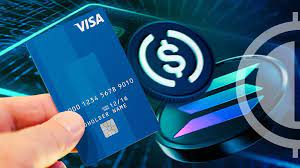Are Visa’s instant settlements signposting the future?
The announcement by PayPal last month that it is launching its own stablecoin PayPal USD, and Visa a couple of weeks ago, that it is extending its activities in stablecoin and blockchain-based processing seems to be building towards something. The base technology has been there for a long time, but only now are large corporations starting to experiment with real use cases (with the exception of China’s Ant Financial, which launched its blockchain-based platform for settling foreign currency payments three years ago). This goes even further than what our previous article predicted, and opens up more opportunities for technopreneurs.
Visa has partnered with Circle, the issuer of USDC, one of the most widely traded USD stablecoins (and “stable” due to its $25Bn liquidity), compared with Tether’s USDT, which has over $80Bn of liquidity. The Visa partnership using USDC stablecoins and the Solana blockchain enables the instant settlement of transactions, particularly those cross-border, which can often take days, also making the transactions immutable.
I think that we are all aware of the fraud risks associated with the latency of transaction settlement. As a personal example a couple of years ago over Christmas I saw on my phone a credit card payment from my account going to a hotel in Scotland – many thousands of ZAR. What followed did not fill me with confidence in the system as I don’t know what would have happened if I had not intervened.
It turns out that I was the target of a fraud where the hotel booking transaction would get cancelled by a friendly fraudster who would call the hotel for cancellation of the room booking and get a refund of the amount paid before I had a chance to query the transaction! I would have had to take up the issue with the card company. The fraud was dependent on the settlement time of the transaction, hence carrying out the fraud attempt at Christmas time when people may not be keeping an eye on their accounts.
Stablecoins are a type of crypto currency that (among other uses) can track the value of a “fiat” currency such as the USD. This can be effected by offering a token which is backed by a “fiat” dollar deposited in a recognised institution. The transparency of fiat holdings is key to confidence, and the mainstream stablecoins mentioned above are backed by fiat holdings which are disclosed. This allows instant transfer of USD value without going through the US dollar clearing and settlement process – an innovation that has huge repercussions.
Regulation around stablecoins is still one of the largest uncertainties. The “grey” is the trading of foreign currency and/or crypto instruments in certain jurisdictions. Foreign exchange controls, for example, exist in many countries and although the stablecoin is not a “real” currency, it can represent a real deposit. These countries often don’t yet have regulation for crypto currencies and this trade is therefore not illegal, although some countries, particularly in Africa, have gone to the extent of banning all crypto. The debate in each will be to what extent is fiat and crypto interchangeable?
The most exciting part of Distributed Ledger technology (DLT) platforms is that they can overcome the complex process of securities or currency trading today – that being execution, clearing and settlement. By using DLT, one can swap a token instantly, meaning instant delivery – such as a Pound for a Dollar or Dollars for a Google share. Coming from a banking background, I can also see advantages such as no settlement risk, as there can be no relative value change, by definition, if the tokens are exchanged immediately.
The bottom line is that the use of stablecoins makes the user journey seamless but, more importantly, the SWIFT hegemony may well be broken and the payment industry properly democratised. Visa and MasterCard may yet re-invent themselves by applying these same technologies, although there may no longer be space for the “middleman” taking a significant commission.
We are looking forward to the changes in this space as major players extend their entire clearing and settlement systems to blockchain, allowing immediate settlement of all financial transactions.
The time has come for technopreneurs…..
